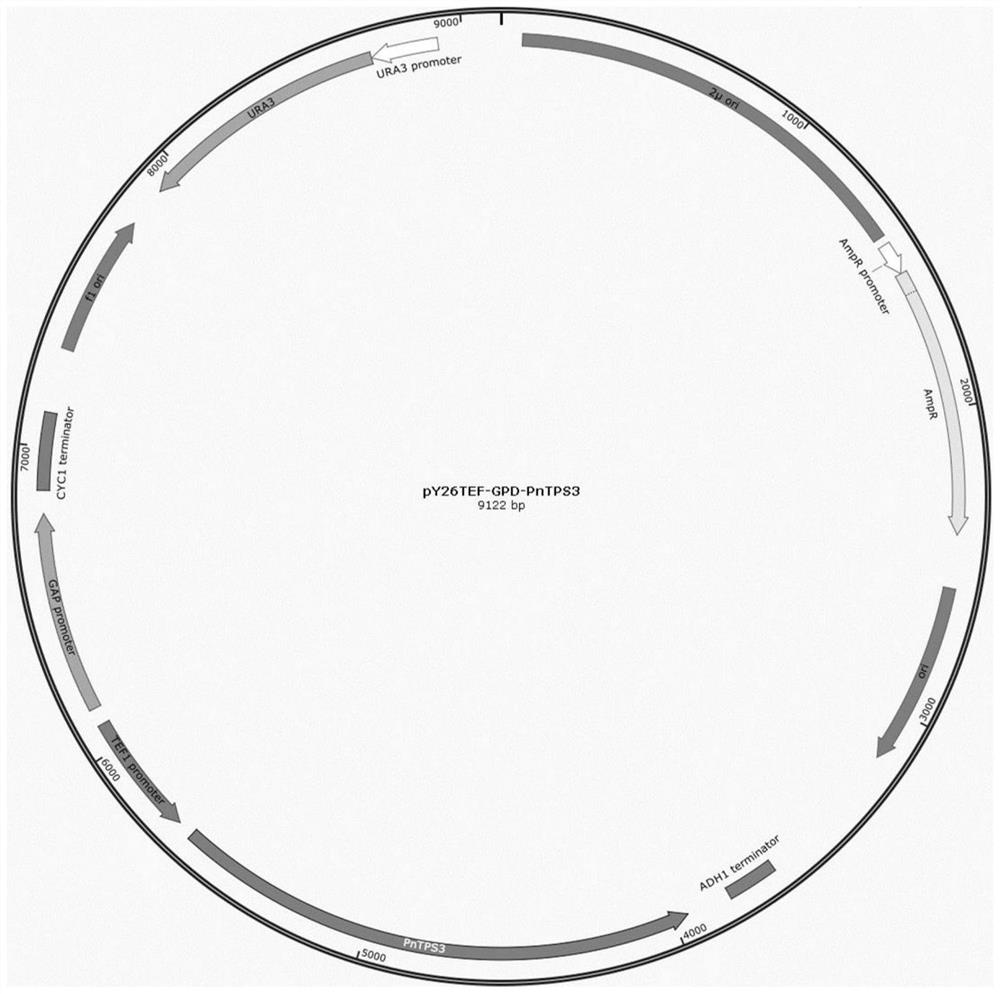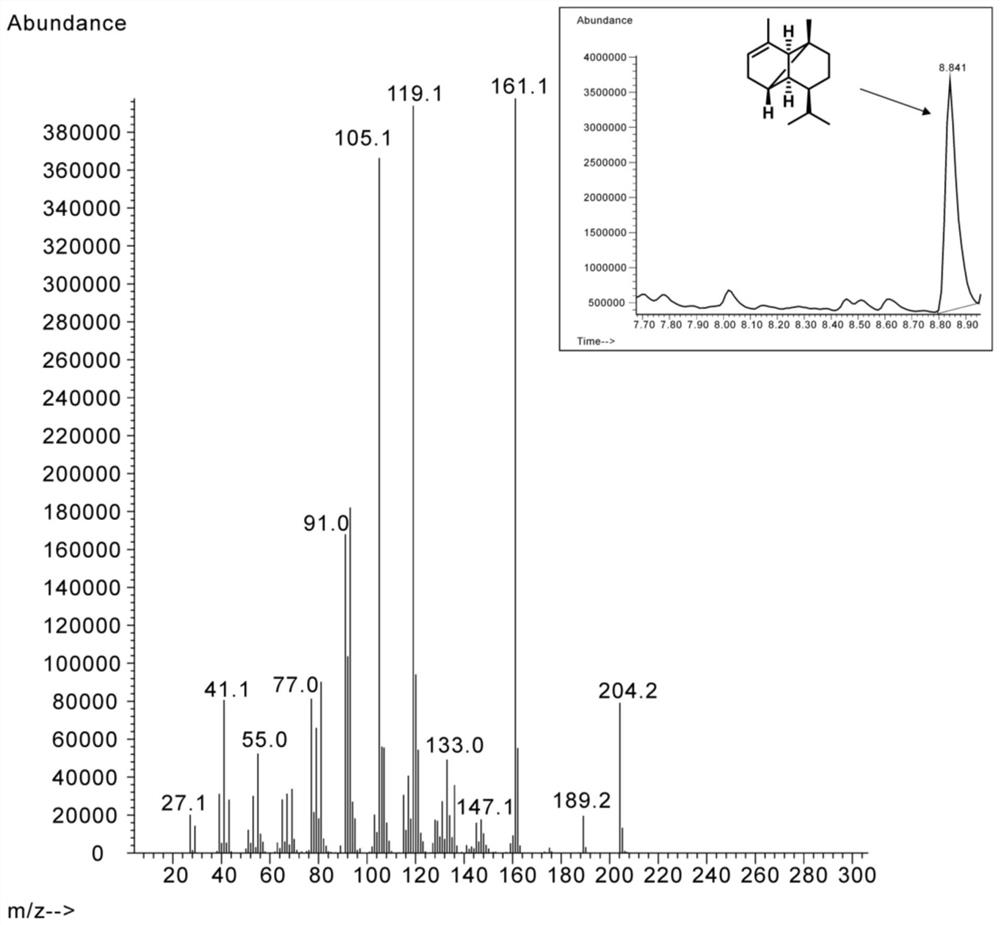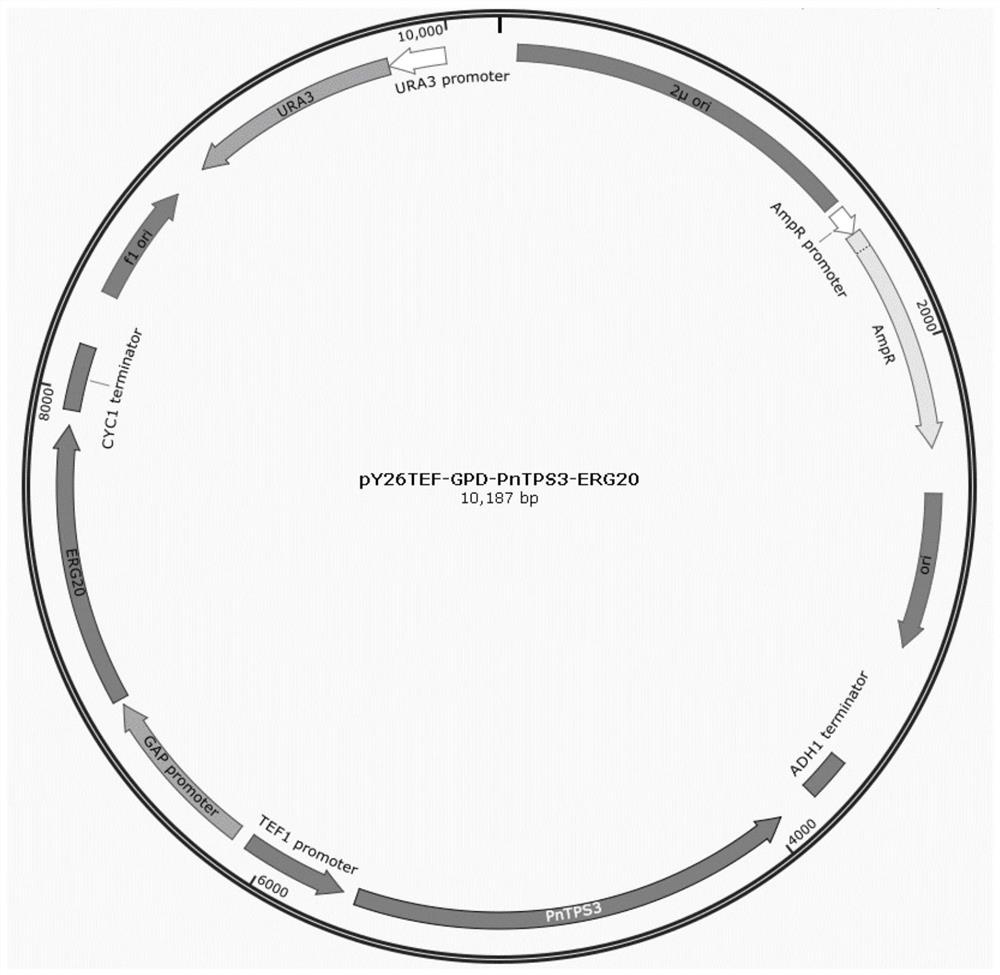Recombinant saccharomyces cerevisiae for producing alpha-cubene and application thereof
A strain of Saccharomyces cerevisiae and the technology of cubene, applied in the field of metabolic engineering and bioengineering, can solve problems such as high cost, consumption of petroleum resources, environmental pollution, etc., and achieve the effects of easy transformation, fast metabolism and reduced consumption
- Summary
- Abstract
- Description
- Claims
- Application Information
AI Technical Summary
Problems solved by technology
Method used
Image
Examples
Embodiment 1
[0028] Synthesize the gene PnTPS3 (nucleotide sequence shown in SEQ ID No. 4) encoding α-cubane synthase, using the PnTPS3 gene as a template, by using the following primers to PCR amplify the PnTPS3 gene fragment:
[0029] PnTPS3 upstream primer: AACTCCGGACCGCGGAGATCTATGGGCTTTTCTTTTGTAAC,
[0030] PnTPS3 downstream primer: AGAATTGTTAATTAAAGATCTTTAGAGGGGGATAGGTTGGA.
[0031] The pY26TEF-GPD was digested with BglII enzyme to obtain the linearized pY26TEF-GPD plasmid, and then the amplified PnTPS3 gene fragment and the linearized pY26TEF-GPD plasmid were connected by homologous recombination (recombinase was purchased from Nanjing Nuowei) Zan company, product number C115), obtained plasmid pY26TEF-GPD-PnTPS3, its schematic diagram is shown in figure 1 .
[0032] The plasmid pY26TEF-GPD-PnTPS3 was transformed into Saccharomyces cerevisiae BY4741, and the successful transformants were screened by uracil auxotrophy to obtain the strain BY4741 / pY26TEF-GPD-PnTPS3, and the successfu...
Embodiment 2
[0040] The same as Example 1, the difference is that the farnesyl pyrophosphate synthase gene (nucleotide sequence shown in SEQ ID No. 5) is further overexpressed to increase the amount of farnesyl pyrophosphate in Saccharomyces cerevisiae.
[0041] The plasmid pY26TEF-GPD-PnTPS3 constructed in Example 1 was selected. The gene encoding farnesyl pyrophosphate synthase ERG20 was constructed into plasmid pY26TEF-GPD-PnTPS3 to obtain plasmid pY26TEF-GPD-PnTPS3-ERG20.
[0042] Using the genome of Saccharomyces cerevisiae BY4741 as a template, the ERG20 gene fragment was amplified by PCR using the following primers:
[0043] ERG20 upstream primer: GATTCTAGAACTAGTGGATCCATGGCTTCAGAAAAAAGAAAT,
[0044] ERG20 downstream primer: TTCCTGCAGCCCGGGGGATCCTTATTTGCTTCTCTTGTAAA.
[0045] The pY26TEF-GPD-PnTPS3 was digested with BamHI enzyme to obtain the linearized pY26TEF-GPD-PnTPS3 plasmid, and then the amplified ERG20 gene fragment and the linearized pY26TEF-GPD-PnTPS3 plasmid were connecte...
Embodiment 3
[0050] Same as Example 2, the difference is that α-cubane synthase and farnesyl pyrophosphate synthase are fused and expressed.
[0051] The plasmid pY26TEF-GPD was selected. The gene ERG20 encoding farnesyl pyrophosphate synthase and the gene PnTPS3 encoding α-cubane synthase were constructed on plasmid pY26TEF-GPD to obtain plasmid pY26TEF-GPD-PnTPS3-L-ERG20.
[0052] Using the PnTPS3 gene as a template, the PnTPS3 gene fragment was amplified by PCR using the following primers:
[0053] PnTPS3 upstream primer: AACTCCGGACCGCGGAGATCTATGGGCTTTTCTTTTGTAAC,
[0054] PnTPS3 downstream primer: GAGGGGGATAGGTTGGACAA.
[0055] Using the genome of Saccharomyces cerevisiae BY4741 as a template, the ERG20 gene fragment was amplified by PCR using the following primers:
[0056] ERG20 upstream primer: TCCAACCTATCCCCCTCGGTTCTGGTATGGCTTCAGAAAAAGAAAT,
[0057] ERG20 downstream primer: AGAATTGTTAATTAAAGATCTTTATTTGCTTCTCTTGTAAA.
[0058] The pY26TEF-GPD was digested with BglII enzyme to ob...
PUM
 Login to View More
Login to View More Abstract
Description
Claims
Application Information
 Login to View More
Login to View More - R&D
- Intellectual Property
- Life Sciences
- Materials
- Tech Scout
- Unparalleled Data Quality
- Higher Quality Content
- 60% Fewer Hallucinations
Browse by: Latest US Patents, China's latest patents, Technical Efficacy Thesaurus, Application Domain, Technology Topic, Popular Technical Reports.
© 2025 PatSnap. All rights reserved.Legal|Privacy policy|Modern Slavery Act Transparency Statement|Sitemap|About US| Contact US: help@patsnap.com



